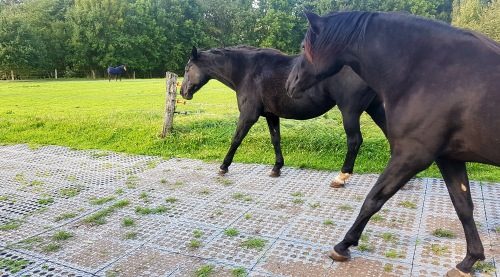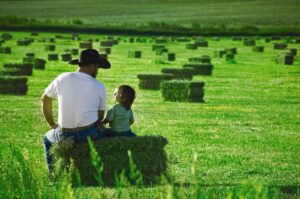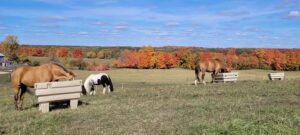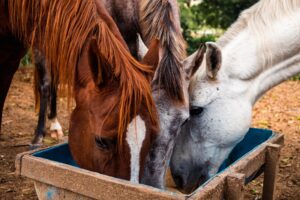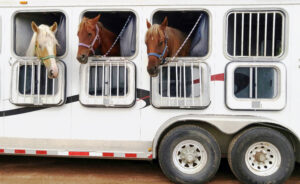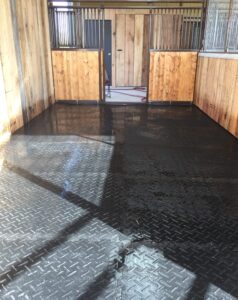
Mud Solutions Part 3: Maintaining Pastures in the Summer
Saddle Up July 2020 – Lisa Kiley
Last month, we touched base on some of the key concepts of mud management around the farm. This month, we will go a bit further in depth in pasture management in the height of grazing season. By this point, the pastures are in a drier condition and horses may be spending even more time out in the field enjoying the good weather and grass. However, without careful management, it’s easy for pastures to become overgrazed weed patches that offer little to no value for supplemental grazing and eventually become a muddy mess.
Take a Walk – To get a good feel for the health of your pastures, take the time to walk around and observe what is going on at the ground level. From afar, pastures can look like they are in better condition than they really are. Horses prefer to be selective about what they eat and like to graze close to the ground. Because of this tendency, they can create bare patches if they over-graze the same areas while leaving other areas of the pasture over-grown. When areas become over grazed, it is easy for weeds to come in and start taking up space in areas of the pasture.
Assess Soil Health – If it seems like the pasture looks like it may need some help, the best thing to do is consult with your local county extension office. They are an invaluable resource for help with getting a soil test that can provide information on what you can do for your pasture. Fertilizer or lime may need to be added to help amend the soil and create better production of grass. Prior to turning out, the pasture should also be assessed for weeds that may be poisonous to horses. An extension office can also help with weed identification and a plan of action if a species needs to be removed from the field before the horses can safely graze.
Implement Rotational Grazing – Rotational grazing is the best practice when it comes to creating a pasture that will produce quality forage for horses. It allows areas to rest and grow back without grazing interference while the horses are moved to the next area. If the grass is not given time to rest, it will weaken the root system and overtime, the plant material will deplete its resources and capability to grow properly. Horses can begin to graze areas once they have reached 6-8 inches and moved when the pasture is down to 3-4 inches. In the spring and early summer, grazing areas will recover more quickly. Grasses will start to take longer to recover in the mid-summer through the fall.
Plan Your Pasture Layout – Pastures need to be divided into multiple, smaller areas so that the horses can be moved from one to the next. Electric fencing is often a popular option to create these grazing areas within the parameter of a larger area. Make sure that the fencing being used is horse safe. One way to maximize your resources is to have several pasture areas that are connected to a main point where horses can come up to drink water and seek shelter, this will save having to outfit each individual grazing area with these features. It’s best if this central area has footing that has been amended to be mud resistant and is situated on a higher point in the pasture.
Mowing for Optimal Growth – Mowing after the pasture has been grazed will help even out what the horses have left in the field. Regular mowing helps to make the grass stronger by encouraging the production of more leaves and fewer stems, which will be tastier to the horses. Mowing also helps with weed management, stunting their ability to multiply, which chokes out the growth of good grasses in the pasture. In a rotational grazing program, the pasture should be mowed after the horses have grazed it down to 3-4 inches and then rested until it grows enough to be grazed on again. However, don’t mow too frequently, because that can lead to a stunted root growth. If pastures need to be re-seeded, the late summer is usually the best time and should be done when the horses can be kept off that area to allow the grass to grow.
Manage Manure by Harrowing – As you look around, you may also notice areas where manure is more frequent. These areas can lead to bare spots and weed seeds can be perpetuated through a horse’s manure. So, what does good manure management look like in a pasture? Breaking up clumps of manure is an easy way to prevent piles from mounding. Using a harrow is the easiest way to accomplish this. It will not only disperse the manure around the pasture, it can also help the health of the pasture by adding organic matter and prevents the piles from smothering grass. Regular harrowing also aids in the management of flies and parasites that are attracted to and live in the manure piles.
Great pastures require thoughtful monitoring and timely management, but when horses are able to graze, it can really lead to huge savings on feed costs. Next month, we will take a closer look at what it takes to make a sacrifice area, when to use it, and some great footing options.






